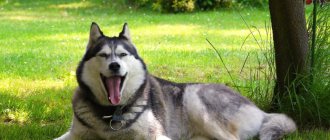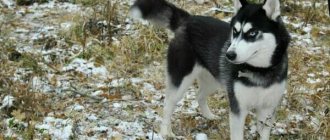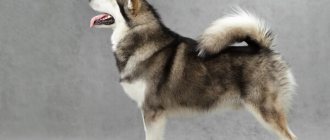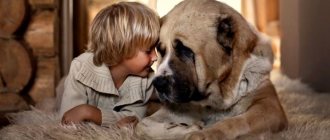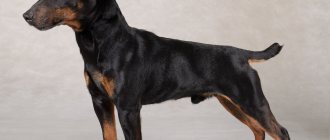Similarities
- Both breeds appeared in difficult climatic conditions and are very hardy animals.
- Huskies and Malamutes have proven themselves to be loyal friends and reliable companions. In practice, there has not yet been a single case of causeless aggression in dogs of these breeds, except in cases where the person himself posed a threat.
- Both breeds are highly intelligent, easy to train, and very good with children.
- There is a general dislike for the cat family; other dogs are friendly.
- Both breeds are very beautiful in appearance, and it is simply impossible not to fall in love with a Husky or Malamute puppy. The breeds are very clean, odorless, habituated, ask for food when needed, and are ideal for keeping in the house . They belong to the hunting breeds and have a natural instinct to hunt. But, despite their hunting instincts, dogs love affection; provide it to your pet, no matter what breed it is.
- These dogs are very demanding of themselves from the owner. These are working breeds of dogs that need daily exercise - very active walks 2-3 times a day for 1-2 hours. Otherwise, the dog simply goes crazy from the energy bursting out of it and this can turn out in the most unexpected way. Have you ever wondered why the most advertisements about lost dogs are of these breeds?
- Grooming is a must!
External differences
The Malamute is another northern sled dog breed. Outwardly, they are very similar to huge wolves, but have a good-natured and affectionate character. Unlike graceful huskies, malamutes have a massive, heavy structure, thanks to which they are able to pull sleds with a large load. These dogs work well in a team, but have strong leadership qualities.
If he recognizes his owner as a leader, he will faithfully serve him all his life. Compared to the lively nature of Huskies, Malamutes are calmer and more balanced. Another interesting character trait common to both Malamutes and Huskies is their dislike for cats. You shouldn’t try to make them friends with small dogs either.
Both breeds are highly intelligent. But to succeed, the dog handler needs to interest and captivate the dog. In addition to excellent working qualities, huskies can make good guard dogs, while malamutes are absolutely non-aggressive and affectionate with all people. An important difference between Malamutes and other dogs is the absence of barking; they only sometimes “mutter.” This feature remained from their ancestors - wolves.
Many people believe that huskies and huskies are the same thing. This idea is completely wrong. First of all, because the husky is a sled working breed, and the husky is a hunting breed. Laika is a northern representative of the Spitz class. From their famous ancestors, dogs received protruding ears and a fluffy tail, beautifully curved in a ring. Laikas have strongly expressed hunting qualities, and slightly less guard qualities. The dogs have a friendly and affectionate character.
To choose the right dog, you need to decide for what purpose it is needed. If you are choosing a dog for sporting competitions, then the best choice would be an Alaskan husky. Malamutes and huskies are ideal for harness work. But, more often than not, when choosing a dog, we choose a pet and a friend. In order for the years of life together to bring only joy, you need to be prepared for the manifestations of certain aspects of character inherent in a particular breed.
For example, a husky feels better in a group of dogs. They have a lot of energy and if the dog has nowhere to spend it, the active mind begins to come up with activities that usually do not please the owner. Huskies need to be given a lot of time, walked a lot, and allowed to run without a leash. If a dog runs around in the yard, then the area should be surrounded by a high fence, dug deep into the ground.
If there are no athletes in the family who can wear out active huskies, then it is better to choose a calmer Malamute. They get along well with people and children. The downside of this breed is that they are difficult to train. But once you communicate with a Malamute, it is impossible not to fall in love with this kind, grumbling wolf.
Among the huskies, you can choose a snow-white Samoyed, a very affectionate Yakut husky, or the largest representative of this species - the East Siberian husky. All types of huskies have good hunting qualities and are easily trained for a certain type of prey. With some likes, people also go after bears.
Malamutes and huskies are becoming increasingly popular among dog lovers around the world.
Both breeds are considered irreplaceable helpers and loyal friends of humans.
They become strongly attached to their owner, affectionate and devoted.
Both Malamutes and Huskies were bred in the north, and were used primarily for sled riding.
The historical homeland of the first breed is Alaska, and the second is Siberia.
These dogs are distinguished by high endurance and the ability to tolerate low temperatures well.
The debate about which dog breed is better has been going on for a long time, but it is still a very subjective question.
The best physical abilities are noted in the husky, but the speed qualities are noted in the husky.
So, let’s look at how huskies and malamutes differ from each other.
Here is a comparison of the physical abilities and temperament of the Husky Malamute breeds:
- Hunting skills. Both dogs know how to hunt and are distinguished by their keen eyesight, good scent and endurance.
- Ride quality. Huskies and Malamutes are bred specifically for sled riding. Compared to its brother, the Malamute can pull heavier loads over longer distances. Its running speed is not high, unlike its ability to carry a small load quite quickly. Huskies are lighter dogs that often take part in speed competitions.
- Character. Malamutes and huskies behave completely differently. The former are distinguished by a calmer character and friendly attitude. The latter, on the contrary, are cunning, curious and temperamental. Husky will find a common language with children. These dogs love to play and never show unmotivated aggression towards both humans and other animals. Malamutes will not take care of babies and babysit them, but they will become a loyal friend to their owner.
They are naturally able to find themselves in the wild forest. However, they will not give their prey to a person, and they will not bring back a shot animal.
We suggest you read: What is the difference between an Alaskan Malamute and a
Husky? Huskies are very vocal and loud dogs, while Malamutes, on the contrary, are silent, they almost never bark.
Many people confuse these two breeds with each other.
The difference in appearance, at first glance, may not seem too obvious.
Let's figure out what differences are present in dogs of these breeds.
External differences of dogs:
- General Appearance: The Alaskan stands out compared to his fast friend due to his more powerful and athletic build. Husky is slightly smaller in size - it is a medium-sized breed. His movements are lighter and more elegant.
- Height at the withers: Huskies average 53 to 56 cm, which is 10-12 cm less than a Malamute.
- Weight: Malamutes are heavier on average by 10-12 kilograms. The weight of both breeds is proportional to their height. However, Huskies are prone to overeating and obesity, which is not observed in the Alaskan brother.
- Coat: Coarser, stiffer and standier in the Malamute. Huskies are characterized by having a double, soft and smooth coat.
- Color: almost any color is allowed for the Siberian representative (from black to snow-white). But a Malamute can have a light gray, black, red sable, brown and white coat. The only solid color can be white. Its main difference is the characteristic mask on its face.
- Eyes: Huskies are famous for their bottomless blue eyes. Very rarely there are individuals with brown and multi-colored eyes. But the Malamute’s eyes are effectively outlined with a black edging and their color, in most cases, is brown.
- Tail: not too curled and carried upward in Alaskans. Siberians are distinguished by a fluffy, curled, down-turned tail that looks like a fox's.
This description should help you distinguish between the Malamute Husky breeds.
When crossing dogs, they often end up with the appearance of a husky and the character of a malamute.
Such offspring are considered outbred and are not intended for further breeding.
Although the cubs born from such a marriage are very cute, smart and good-natured.
Malamutes, huskies and their crosses are northern dogs with excellent working qualities and good character. At first glance, they are very similar to each other, but at the same time completely different.
Due to the fact that the “first” breed was crossed with local representatives of dogs, both in Siberia and Alaska their appearance is slightly different. Externally, Malamutes are taller than Siberians. Their dimensions can reach 64 cm, while “Siberians” do not exceed 56 cm. The big difference lies in weight, dogs from Alaska weigh 39 kg, and from the north of Russia - no more than 28-30 kg. It should be said about the wool cover.
Malamutes have significantly longer hair than Huskies, giving them a fuller appearance. The massive wool allows them to withstand extremely low temperatures, which are unbearable even for Siberians. But such a “fur coat” greatly reduces the speed of the Malamute compared to the Siberian. The large size of the Alaskan dog makes it more agile, capable of transporting large loads, but this also affects its endurance; the Siberian dog is able to cover a much greater distance than the Malamute without stopping for a break.
If it is necessary to cover a distance of up to 12-15 km, as a competition, then the difference between the breeds is almost imperceptible: where there is a straight and well-trodden path, the Siberian dog will dominate; on deep and snowy trails, the malamute will take the lead due to its strength, weight and height. That is why they are allowed to participate in the races without classification.
Outwardly, in detail, it is clear how dogs from Alaska and Siberia differ, but the differences also lie in the character of the animals.
Both huskies and malamutes are completely devoted to their owner and there is no difference in this. Their different personalities are immediately evident in terms of training. Alaskan dogs are calmer and “softer”. The Malamute instantly learns new commands and is able to act in accordance with any instructions from a person.
We invite you to read: How to care for a husky in an apartment and a private house: keeping it at home.
Malmut is extremely obedient and gets along well with children. The Siberian dog is a Klondike of energy and loud bark. The dog is also very friendly and gets along with any other animals, but training “Siberians” is a real test. Husky does not listen, during the training process he instantly loses interest in everything that is happening, and suffers from absent-mindedness. The animal just needs to run constantly.
Visual differences between dogs
Look at these photos, we are sure that after this there will be no questions left about how the Alaskan Malamute differs from the Siberian Husky:
Husky
Malamute
Husky
Malamute
And these are the puppies:
Features of maintenance and care
Malamutes and huskies are energetic and require long walks and active games. A house with a spacious garden area where they can move freely is best suited for keeping. It is more difficult to keep pets in an apartment.
- mandatory hygiene procedures;
- periodic combing;
- bathing.
Alaskans should be limited in their diet - dogs are prone to overeating. Siberians are much more restrained in this regard.
Huskies and Alaskan Malamutes are distinguished by good health. But sometimes they suffer from diseases of the eyes, skin and musculoskeletal system.
Crossbreed
When these breeds are crossed, wonderful creatures are obtained: Haskomuts or Aluskys (Aluskys)
